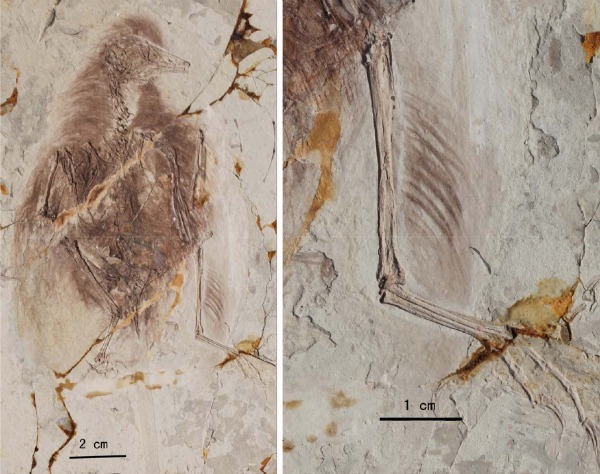Prehistoric Birds May Have Used Four Wings to Fly
A study of fossils of prehistoric birds suggests two sets of wings—one set on the creature’s hind legs—helped avians stay aloft
![]()

A fossil of a prehistoric bird from the enantiornithine genus shows feathers on its hind legs—evidence of an extra pair of wings. Courtesy of Xiaoting Zheng et al/Science
Roughly 150 million years ago, birds began to evolve. The winged creatures we see in the skies today descended from a group of dinosaurs called theropods, which included tyrannosaurs, during a 54-million-year chunk of time known as the Jurassic period. Why the ability to fly evolved in some species is a difficult question to answer, but scientists agree that wings came to be because they must have been useful: they might have helped land-based animals leap into the air, or helped gliding creatures who flapped their arms produce thrust.
As researchers continue to probe the origin of flight, studies of fossils have shown that theropods–particularly coelurosaurian dinosaurs, which closely resemble modern birds—had large feathers on both their fore limbs and hind limbs. However, extensive evidence for these leg feathers didn’t exist in the earliest birds. But now, a new examination of fossils reported today in the journal Science reveals several examples of this four-winged anatomy in modern birds’ oldest common ancestors.
Modern birds have two types of feathers: vaned feathers that cover the outside of the body, and the down feathers that grow underneath them. Researchers studying the approximately 120 million-year-old fossils of 11 primitive birds from the Shandong Tianyu Museum of Natural History in China found that one type of vaned plumage, also known as pennaceous feathers, was neatly preserved in skeletal fossils of these specimens, along each creatures’ hind limbs. After this find, the researchers must have been flying high: The feathers of birds’ wings, known as flight feathers, are long, stiff and asymmetrically shaped pennaceous feathers, similar to those found in the fossils. When fanned together, pennaceous feathers form the broad surfaces of birds’ wingspans—without these surfaces, birds cannot stay aloft.
Pennaceous feathers, which are composed of many flattened barbs, existed in some winged dinosaurs. Finding them on the hind legs of early birds suggests that before birds used two wings to fly, they may have depended on four. Over millions of years, however, birds gradually lost the feathers on this extra set of wings.
The study adds to existing theories that suggest the first birds flew with four wings. Examination of a primitive bird fossil from the Archaeopteryx genus in 2004 revealed long feathers on the animal’s back and legs, which would have aided its gliding ability. Two years later, another study of the crow-sized animal, which lived about 150 million years ago, reported that the prehistoric bird’s feathers resembled those on modern birds’ flight wings.
One of the more complete skeletons examined in today’s study actually showed hind-limb pennaceous feathers along the bone of each leg. The longest feather stretched almost two inches, which is remarkable considering that the legs they covered were between one inch and two and a half inches long. In fact, specimens from a group of birds called Enantiornithes, which externally resemble modern birds, showed symmetrically paired large feathers preserved along their hind leg bones. Such feather arrangement is present in modern birds’ wings.
Researchers speculate that the second set of wings might have provided extra lift or created drag in the air. They might also have helped birds maneuver their airborne bodies.
If these hind wings indeed served a functional purpose in fight, they will earn an important place in bird evolution. Bird movement is characterized by a combination of feathered arms for flight and legs for walking on land. This study suggests that if walking legs, present in birds today, developed after these feathered hind legs, then the loss of feathers on the back legs—and thus an extra pair of wings—reflects a period of change during which the arms became specialized for flight and the legs, for locomotion.
Today, leg feathers are less well developed than wing feathers—they are usually much smaller and fluffy—and they serve as protection and insulation for the leg. These fluffy bits are sparse too—instead, the legs are covered in scales, which form only if feather growth is inhibited. Studies of modern birds show how this works. As chicks develop from embryos and grow into adults, feathered legs can be transformed into scaled legs, or vice versa, by altering how certain genes are expressed.
The recent revelation about feathers on birds’ hind legs suggest that a similar genetic, and more permanent, change might have occurred early in bird evolution, according to lead researchers. This shift triggered the loss of birds’ hind wings, pushing the creatures down an evolutionary path that would allow them to fly with just two.
/https://tf-cmsv2-smithsonianmag-media.s3.amazonaws.com/accounts/headshot/marina-koren-240.jpg)
/https://tf-cmsv2-smithsonianmag-media.s3.amazonaws.com/accounts/headshot/marina-koren-240.jpg)